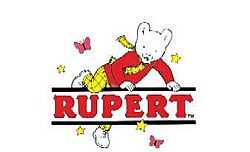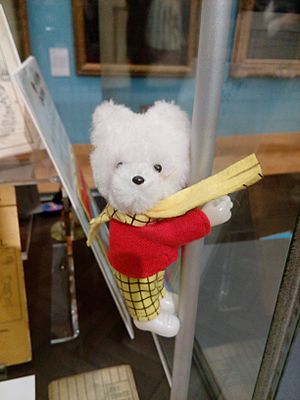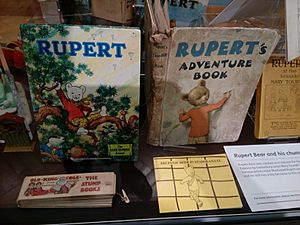Rupert Bear facts for kids
Quick facts for kids Rupert Bear |
|
|---|---|

Logo for Rupert Bear
|
|
| Publication information | |
| Publisher | Daily Express |
| Format | Text comics, later balloon comics too. |
| Genre | Adventure comics, Fantasy comics |
| Publication date | 1920–present |
| Main character(s) | Rupert |
| Creative team | |
| Writer(s) | Mary Tourtel (1920–1935) Alfred Bestall (1935–1974) Freddie Chaplain (1965–1978) James Henderson (1978–1990) Ian Robinson (1990–2002) Stuart Trotter (2008–present) |
| Artist(s) | Mary Tourtel (1920–1935) Alfred Bestall (1935–1974) Alex Cubie (1975–1977) John Harrold (1978–2007) Stuart Trotter (2008–present) |
Rupert Bear is a super famous British cartoon character! He first appeared in the Daily Express newspaper on November 8, 1920. An artist named Mary Tourtel created him. Rupert was first made to help the newspaper sell more copies.
Later, in 1935, Alfred Bestall took over writing and drawing Rupert's adventures. He was really good at making stories for kids. Bestall worked on Rupert's adventures until he was in his 90s! Today, other artists and writers continue the series. Over 50 million Rupert books have been sold around the world.
Rupert's adventures are still printed every day in the Daily Express newspaper. Many of these stories are also put into books. Since 1936, a special Rupert annual book has come out every year. Rupert Bear is a very well-known character in children's culture in the United Kingdom. His stories have even become several TV shows! Rupert also has many fans, like a group called The Followers of Rupert.
Contents
Meet Rupert and His Friends
Rupert is a friendly bear who lives with his parents. Their home is in a peaceful, made-up English village called Nutwood. You can always spot Rupert because he wears a red jumper and bright yellow checked trousers with a matching yellow scarf. He was first drawn as a brown bear. But his color soon changed to white to save money on printing! He stayed brown on the covers of the annual books, though.
Most of Rupert's friends are also animals. But they act and look a bit like humans! This is called anthropomorphic. All of Rupert's animal friends are about the same size as him. Rupert calls them his "chums" or "pals."
His best friend is Bill Badger. Some other long-time friends include Edward Trunk the elephant, Willie the mouse, and Pong-Ping the Pekingese dog. There's also Algy Pug, Podgy Pig, Bingo the Brainy Pup, and the fox twins Freddie and Ferdy. You'll also meet Reggie and Rex Rabbit, who are identical twins, and Ming the dragon.
The kind Wise Old Goat lives in Nutwood too. He often helps Rupert on his adventures. One unique character is Raggety. He's a woodland creature made from twigs. Raggety can be grumpy sometimes! In a 2006 TV show, Raggety became a friendly elf. There's also a police officer dog named PC Growler.
Some human characters appear in the stories too. There's the Professor, who lives in a castle with his helper, Bodkin. Tiger Lily is a Chinese girl, and her father is "the Conjuror." Other characters include Sailor Sam, Gaffer Jarge, Captain Binnacle, and Rollo, a Gypsy boy. A Merboy also shows up often.
Alfred Bestall added new characters when he wrote the stories. These include the girl guides Beryl, Pauline, and Janet. Beryl's cat, Dinky, is also part of the group. These characters were based on real Girl Guides who asked Bestall for their own adventure with Rupert! They are still in the comic series today.
Rupert's Amazing Adventures
Rupert's stories often involve exciting and magical trips to faraway places. Each adventure starts in Nutwood. Rupert might set out to do a small chore for his mom or visit a friend. But then, his simple task turns into a big adventure! He might travel to King Frost's Castle, the Kingdom of the Birds, deep underground, or even to the bottom of the sea.
Sometimes, one of the Professor's cool inventions helps Rupert start an adventure. At the end of every story, Rupert always returns safely to Nutwood. His parents seem completely calm about all his amazing journeys!
How Rupert's Stories Are Told
Rupert Bear stories are special. Unlike most modern comic strips, they don't use speech balloons. Instead, the pictures have text next to them. This style is called "text comics".
Alfred Bestall created the classic Rupert story style. The story is shown in pictures, usually two panels each day in the newspaper. In the annual books, there are four panels per page. The story is also told in short rhyming lines above the pictures. And there's a longer story written below the pictures. This means you can "read" Rupert Annuals in four different ways!
Rupert Books
Rupert Bear Annuals
A special Rupert Bear annual book has been released every year since 1936. This even happened during World War II, when paper was hard to find!
- #1–38 = Alfred Bestall
- #39–42 = Alex Cubie
- #43–72 = John Harrold
- #73–current = Stuart Trotter
|
Rupert Little Bear Library
Mary Tourtel wrote and drew all these books. They were first published from 1928 to 1936. There were 46 books in the first series.
- Rupert and the Enchanted Princess (1928)
- Rupert and the Black Dwarf (1928)
- Rupert and his Pet Monkey (1928)
- Rupert and his Friend Margot (1928)
- Rupert in the Mystery of Woody (1929)
- Further Adventures of Rupert and his Friend Margot (1929)
- Rupert and the Three Roberts (1929)
- Rupert, the Knight and the Lady (1929)
- Rupert and the Circus Clown (1929)
- Rupert and the Magic Hat (1929)
- Rupert and the Little Prince (1930)
- Rupert and King Pippin (1930)
- Rupert and the Wilful Princess (1930)
- Rupert's Mysterious Plight (1930)
- Rupert in Trouble Again (1930)
- Rupert and the Wooden Soldiers (1930)
- Rupert and the Old Man and the Sea (1931)
- Rupert and Algy at Hawthorn Farm (1931)
- Rupert and the Magic Whistle (1931)
- Rupert Gets Stolen (1931)
- Rupert and the Puss in Boots (1931)
- Rupert and the Christmas Tree Fairies (1931)
- Rupert and His Pet Monkey Again (1932)
- Rupert and the Rubber Wolf (1932)
- Rupert's Latest Adventure (1932)
- Rupert and Humpty Dumpty (1932)
- Rupert's Holiday Adventure (1932)
- Rupert's Christmas Tree (1932)
- Rupert, the Witch and Tabitha (1933)
- Rupert Goes Hiking (1933)
- Rupert and Willy Wispe (1933)
- Rupert Margot and the Bandits (1933)
- Rupert and the Magic Toyman (1933)
- Rupert and Bill Keep Shop (1933)
- Rupert and Algernon (1934)
- Rupert and Beppo Again (1934)
- Rupert and Dapple (1934)
- Rupert and Bill's Aeroplane Adventure (1934)
- Rupert and the Magician's Umbrella (1934)
- Rupert and Bill and the Pirates (1935)
- Rupert at the Seaside (1935)
- Rupert Gets Captured (1935)
- Rupert, the Manikin and the Black Knight (1935)
- Rupert and the Greedy Princess (1935)
- Rupert and Bill's Seaside Holiday (1936)
- Rupert and Edward and the Circus (1936)
Some of these books were later sold at Woolworth's stores. That series had only 18 of the original titles.
Brainwaves Limited Books
Brainwaves Limited made a series of Rupert storybooks in 1991. They also published other Rupert books like:
- Rupert Mini Board Books
- Rupert Hookbooks
- Rupert Storytime Books
- Rupert Shaped Board Books
- Rupert Flap Books
Rupert on TV and Film
The Adventures of Rupert Bear (1970–1977)
Rupert's first TV show was made by ITC Entertainment. It had 156 episodes, each ten minutes long. The characters were puppets. The opening showed a toy Rupert bear in a child's bedroom. Rupert's friends and his flying chariot looked just like they did in the Daily Express comics. He also got a new friend, a sprite named Willy Wisp.
The show had a very popular theme song. It was sung by Jackie Lee and reached number 14 on the UK music charts in 1971.
Movie: Rupert and the Frog Song (1985)
In 1985, a short movie called Rupert and the Frog Song was released. It was directed by Geoff Dunbar. The ideas and music came from Paul McCartney (from The Beatles!). In the film, Rupert explores the countryside at night. He finds a special gathering of frogs. The movie features a song called "We All Stand Together". This song became very popular, reaching No.3 in the UK music charts.
Rupert (1985–1988)
Rupert came back to TV on the BBC in 1985. This show had 36 short stories, each about five minutes long. Each episode used still pictures from the comics with a narrator telling the story. Ray Brooks was the only narrator.
Rupert (1991–1997)
In 1991, Rupert Bear got a new animated TV show. It had 65 episodes over five seasons. This show was made by companies from Canada and France. It really looked and felt like the original Rupert newspaper comics. Many stories were almost exactly like the ones from the Daily Express.
This show was shown in many countries. In the UK, it was on CITV. In the US, it first aired on Nickelodeon. It also played in Canada, Australia, New Zealand, and Brazil. In 2000, there were plans to make a Rupert movie in Hollywood, but it didn't happen.
Rupert Bear, Follow The Magic... (2006–2008)
A new Rupert Bear TV show was made in 2006. This show used stop-motion animation and was mostly for younger children. Some characters looked different. Rupert wore trainers, and his fur was a bit tan. Bill the Badger wore a leather jacket and used a personal digital assistant. Pong Ping became a girl who used magic. Raggety, the twig creature, became a friendly tree elf. There were also new characters like Miranda the mermaid.
Rupert Bear, Follow The Magic... was shown on Five in the UK. Fifty-two ten-minute episodes were broadcast.
Rupert Video Games
The company Quicksilva made two video games about Rupert Bear. They were for old 8-bit computers like the Commodore 64 and ZX Spectrum. The games were:
- Rupert and the Toymaker's Party (1985)
- Rupert and The Ice Castle (1986)
Rupert Stamps
In September 2020, Royal Mail (the UK postal service) released a set of eight stamps. They celebrated Rupert Bear's 100th birthday! The stamps featured artwork by Alfred Bestall.
Images for kids
-
Rupert Bear exhibit formerly in the Canterbury Heritage Museum




